The healthcare industry is rapidly evolving, and so is how healthcare providers connect with their patients. In today’s digital age, it’s become more critical than ever for healthcare organizations to implement effective digital marketing strategies that’ll help them connect with their patients and improve their overall engagement with them.
Digital marketing in healthcare refers to using various digital channels, such as websites, social media, email, and mobile apps, to promote healthcare products and services.
These digital channels allow healthcare companies and organizations to reach a wider audience, increase brand awareness, and improve patient engagement. You really can’t understate the importance of digital marketing in healthcare.
Patients increasingly turn to the internet to research healthcare information and make decisions about their health. For instance, someone may google whether to get a root canal or an extraction. A pregnant woman may also search for an alternative to repeat cesarean section.
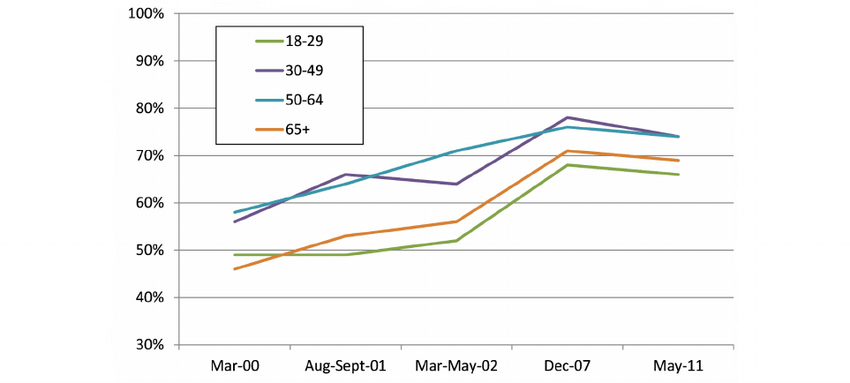
Image source: Researchgate
Pew Research has found that about 59% of patients go online specifically to figure out a medical condition. Very soon, these statistics would increase. That is why healthcare organizations must establish a robust digital presence.
By implementing effective digital marketing strategies, healthcare organizations can:
- Improve patient engagement
- Increase brand awareness
- Enhance patience experience with the company and brand
- Understanding the Healthcare Industry
- The Basics of Digital Marketing in Healthcare
- Creating a Digital Marketing Strategy
- Understanding Your Target Audience
- Content Marketing in Healthcare
- SEO for Healthcare
- PPC Adverts
- Social Media Marketing
- Email Marketing
- Compliance and Ethics in Digital Marketing in Healthcare
- Concluding Thoughts on Maximizing ROI in Healthcare with Digital Marketing
Improve Patient Engagement
With the proper channels, digital marketing allows healthcare organizations to engage with their patients in real time, respond to their queries, and provide personalized recommendations based on their health history and preferences.
Increase Brand Awareness
A robust digital presence can help you increase your brand awareness and build trust with your patients. Moreover, sharing valuable and engaging content with your patients on social media can be one of the most powerful ways to establish yourself as a thought leader in the industry.
Enhance Patient Experience
The various digital marketing tools, such as online appointment scheduling, can help your healthcare organization improve the patient experience by reducing wait times, improving communication, and making it easier for patients to access healthcare services.
Sounds interesting, right?
We will explore all the nitty-gritty of digital marketing in healthcare. Ultimately, you’ll know how to create captivating content, get found on google even though the market is crowded, and have personal ‘one-on-one’ conversations with your patients and clients online.
We’ll also digest how to know if your digital marketing efforts are paying dividends and how to use these digital methods to maximize your ROI while maintaining a solid digital presence in the healthcare industry.
It all starts with an effective marketing strategy.
Understanding the Healthcare Industry
To develop an effective digital marketing strategy in healthcare, it’s essential to understand the healthcare industry’s current landscape, marketing trends, and how digital marketing impacts the industry.
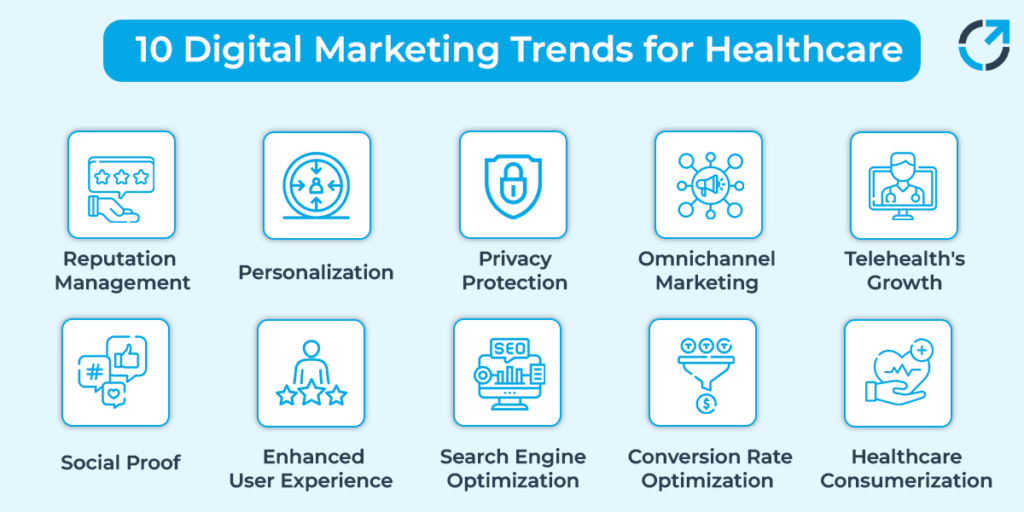
Image source: Searchonic
When we say healthcare industry, we refer to various organizations, such as hospitals, clinics, pharmacies, insurance companies, and medical device manufacturers.
The industry’s primary objective is to provide patients with medical care, support, and services to improve their health outcomes. This industry is highly regulated, and providers must comply with stringent rules and regulations to ensure patients receive safe and effective care.
Over the past few years, healthcare marketing has undergone a significant transformation, with a surge in digital marketing. Nowadays, many health companies utilize various forms of personalization, video marketing, and content marketing to engage their audiences.
Through the use of data analytics, healthcare providers can gain better insight into their patients, create personalized marketing messages, and enhance engagement. Video marketing, in particular, has become increasingly popular in healthcare, as it provides an easy-to-understand format for explaining complex medical procedures and treatments.
In addition to video marketing, healthcare organizations are also using content marketing to offer valuable information to patients, foster trust, and establish themselves as thought leaders in the industry.
Undoubtedly, digital marketing is revolutionizing the healthcare industry by providing patients with access to healthcare information and services at any time and from any place.
In today’s world, patients increasingly rely on digital channels to research healthcare providers, medical conditions, and treatments and communicate with healthcare providers.
Healthcare providers employ digital marketing tools such as social media, email marketing, mobile apps, and search engine optimization (SEO) to reach their target audience effectively.
For healthcare marketers, it’s imperative to adapt to the constantly evolving digital landscape to stay competitive in the industry. You must stay up-to-date with the latest digital marketing trends, keep track of healthcare regulations, and leverage digital marketing tools to reach a wider audience.
Doing so can massively improve your ROI, generate leads, and foster long-term relationships with patients.
The Basics of Digital Marketing in Healthcare
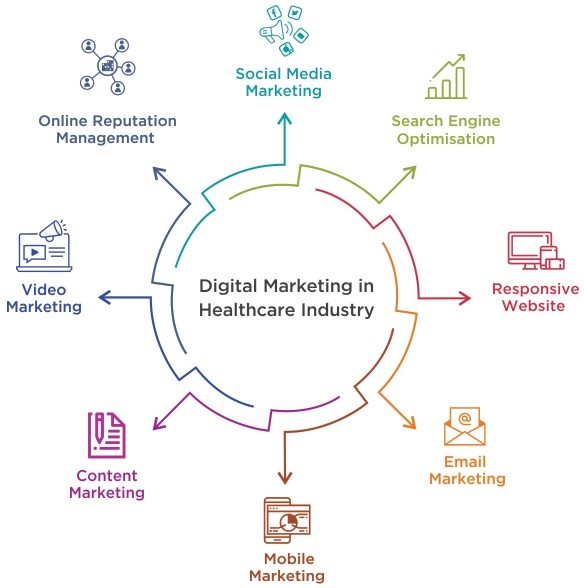
Image source: LQTech
To implement an effective digital marketing strategy in healthcare, it’s essential to understand the different types of digital marketing channels suitable for healthcare and how to create a comprehensive marketing strategy that aligns with your business goals.
Healthcare organizations can leverage several digital marketing channels to reach their target audience effectively. These channels include
Website
A website is a crucial digital marketing channel for healthcare organizations. It’s often the first point of contact for patients looking for healthcare services. A website should be designed to be user-friendly, informative, and engaging.
Search Engine Optimization (SEO)
SEO is optimizing a website to rank higher on search engine result pages (SERPs). Healthcare organizations can use SEO to target and rank for specific keywords to improve their online visibility and attract more patients to their websites. If you are interested in acquiring paid traffic, you may consider a healthcare Facebook marketing campaign or even a Google Ads campaign.
Social Media
Social media platforms, such as Facebook, Twitter, and LinkedIn, allow healthcare organizations to engage with patients, share valuable content, and establish themselves as thought leaders in the industry.
Email Marketing
Email marketing is the most intimate and one-on-one way to converse with customers and patients. It is an effective way for healthcare organizations to communicate with patients, share important updates, and promote healthcare services.
Creating a Digital Marketing Strategy
Creating a strategy for your healthcare marketing efforts is like creating a plan for a house you want to build. The plan would serve as a blueprint to know what to do and when, to structure the house according to your specifications.
To create an effective digital marketing strategy in healthcare, there are a few things you need to do. The first is to…
Define your business goals.
Why do you want to go digital? Is it to get new leads or patients, increase your website visits and traffic, build your brand, and sell products? What exactly do you want to achieve with your digital marketing efforts?
Have a clear and defined goal that you want to achieve with your digital marketing efforts. Setting clear goals is essential for the success of your digital marketing efforts in healthcare. When you’re setting goals, make them specific, measurable, achievable, relevant, and time-bound (SMART).

Image source: Pinterest
Focus on goals that align with your business objectives, such as increasing patient engagement, improving the patient experience, or generating more leads. And after you’ve set your realistic and attainable goals, determine which metrics would serve as key indicators for the success of your strategy. We’ll touch on analytics a bit later in this post.
By setting clear goals and measuring your progress, you can optimize your digital marketing efforts and achieve the best possible ROI.
After setting your goals, the next important thing is to understand those you will serve with your business, aka your customers and patients. After all, how can you engage and resonate with them if you don’t even know them?
Understanding Your Target Audience
Imagine you’re a startup that has developed a new digital health app to help people track their fitness goals and improve their health. You’re excited to launch your app and start marketing it to the world, but you haven’t taken the time to understand your audience.
Without understanding your audience, you might make assumptions about their needs and preferences that may turn out to be incorrect.
For example, you might assume that your audience is primarily interested in weight loss when in fact, they are more concerned with managing chronic conditions like diabetes or heart disease.
Alternatively, you might assume your audience is primarily young adults when your app appeals to various age groups.
However, if you take the time to understand your audience, you can tailor your digital marketing strategy to their specific needs and interests. For instance, if you discover that your audience is primarily interested in managing chronic conditions, you might focus your marketing efforts on highlighting the app’s features that help users monitor their blood sugar levels or track their medications.
If your audience is mainly middle-aged or older, you could advertise your app on platforms that are popular with that demographic, such as Facebook.
You need to know everything about your target customers, their challenges and needs, and create buyer personas that represent them. That is the only way you can reach, engage, and convert them to happy customers of your brand.
The bottom line is to define exactly who your audience is and take the time to know them inside out; know them better than they know themselves.
Defining Your Target Audience
Defining your target audience involves identifying the characteristics of your ideal customers. This includes demographic information, such as age, gender, location, income level, education, and occupation. It also includes psychographic information, such as their values, beliefs, attitudes, interests, and lifestyle.
Collecting this kind of information about your customers is not always easy. But taking the time to do it anyway would pay a lot in the long run. You can use market research tools like surveys, focus groups, and interviews to dig into the lives of your target audience. You can analyze online reviews and social media conversations to identify common complaints and areas for improvement.
You can also use analytics tools to analyze your website traffic and social media engagement to gain insights into your audience’s behavior and preferences.
Apart from knowing who your customers are, you also need to understand the challenges and desires of your target audience. What are their pain points? What motivates them to seek healthcare services? What are their expectations when it comes to healthcare?
With the information you’ve collected about your customer, you’ll create something called a buyer persona.
A buyer persona is a fictional representation of your ideal customer based on the research and insights you have gathered about your target audience. It includes demographic and psychographic information and information about their healthcare needs, challenges, and preferences.
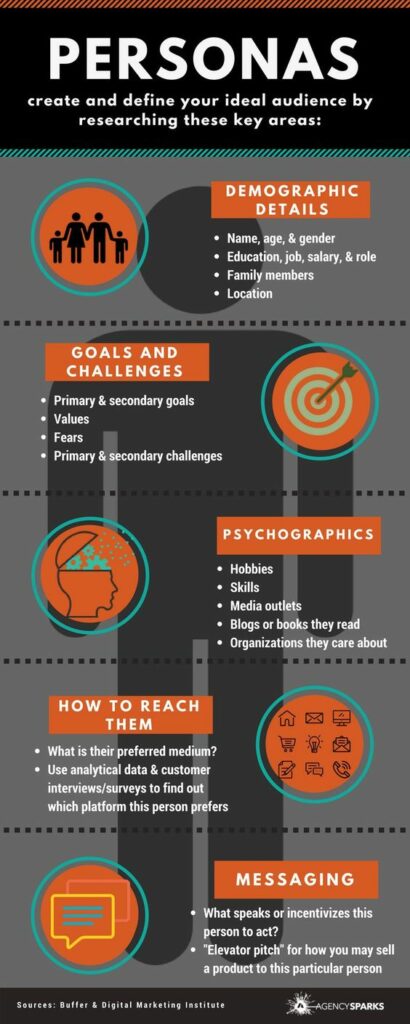
Image source: Pinterest
Give them a name, age, and background information to create a buyer persona. Then, outline their healthcare needs and challenges, and describe how your healthcare services can meet those needs. Finally, include information about their preferred communication channels and other preferences, such as their preferred healthcare providers and payment methods.
Here’s a sample buyer persona;
Name: Emily
Age: 35
Gender: Female
Occupation: Human Resources Manager
Education: Bachelor’s Degree
Location: Urban area
Marital Status: Married with two children
Interests: Fitness, healthy eating, mindfulness, family time
Goals: To provide her family with quality healthcare, to stay healthy and prevent illness, to manage stress effectively
Challenges: Balancing work and family responsibilities, staying on top of her and her family’s healthcare needs, finding time for self-care
Pain Points: Long wait times at the doctor’s office, confusing insurance policies, difficulty finding reliable healthcare information online
Emily is a busy working mom who values health and wellness for herself and her family. She wants to ensure that her family has access to quality healthcare and stays healthy, but she struggles to balance her work and family responsibilities. She is also looking for ways to manage her stress more effectively. Emily is frustrated by long wait times at the doctor’s office and finds insurance policies confusing. She wants to find reliable healthcare information online but is overwhelmed by the amount of information available. A healthcare company that can provide easy-to-understand healthcare information, convenient appointments, and excellent customer service would appeal to Emily.
Understanding your target audience and creating buyer personas like the above can tailor your healthcare marketing campaigns to resonate with your ideal customers, speak directly to their hearts, maximize your engagement, and achieve the best possible ROI.
Unfortunately, many businesses online are not doing this. But if you take the time to prepare your persona, you’ll be way ahead of your competition. With the persona in hand, it’s time to create content for your online brand.
Content Marketing in Healthcare
Content marketing involves creating and distributing valuable, relevant, and engaging content at the right time to attract and retain a clearly defined audience.
In healthcare, content marketing is critical for several reasons. First, it helps to establish your healthcare brand as an authoritative source of information and expertise. Second, it educates patients about their health, leading to better health outcomes and patient satisfaction. Third, it can help you to differentiate your healthcare services from your competitors.
Effective content marketing builds trust and credibility with patients, educating them about their health and promoting your healthcare services. After all, your patients can’t afford to trust just anyone with their lives. You need to show up as the most trusted advisor for their health decisions.
To create engaging and relevant content and copy, you must understand your target audience and their healthcare needs and preferences. You can use your buyer personas to guide your content creation, ensuring that it resonates with your ideal patients, answers all their questions, and solves their problems.
Some tips for creating engaging and relevant content and copy include:
Focus on Patient Benefits
Instead of focusing on your healthcare services’ features, highlight the benefits patients can expect from your services. For example, instead of saying that you offer state-of-the-art equipment, highlight how your equipment can improve patient outcomes.
Use a Patient-centric Tone
When creating content for your audience and customers, use language they can easily understand and avoid medical jargon. Speak to them as individuals, not medical cases.
Leverage Storytelling Techniques
Storytelling is a powerful tool in healthcare content marketing, as it allows patients to connect emotionally with your healthcare brand. Use patient stories to illustrate how your healthcare services can make a difference in their lives.
Various Content Distribution Channels
Once you have created engaging and relevant content, you must distribute it through various channels to reach your target audience. Some of the most effective content distribution channels for healthcare include:
Your website is the hub of your healthcare digital marketing efforts. With it, you can create a blog, publish patient testimonials and case studies, and provide educational resources to attract and engage patients.
Social media: Social media platforms like Facebook, Twitter, and LinkedIn allow you to reach a broad audience and engage with patients in real-time. You can share your blog posts, patient stories, and other relevant content on social media to drive traffic to your website.
Email marketing: Email marketing is an effective way to nurture relationships with patients and keep them informed about your healthcare services. You can send newsletters, educational resources, and other relevant content via email to stay top-of-mind with your target audience.
We’ll discuss these channels in-depth later. Another feature of digital marketing in healthcare that goes hand-in-hand with content is keyword research and SEO.
SEO for Healthcare
Search engine optimization (SEO) is the practice of improving the visibility and ranking of your website on search engines like Google, Bing, and Yahoo. SEO is crucial in attracting patients to your website, educating them about your healthcare services, and improving your healthcare brand’s online reputation.
It involves several techniques that can help you to optimize your website for search engines.
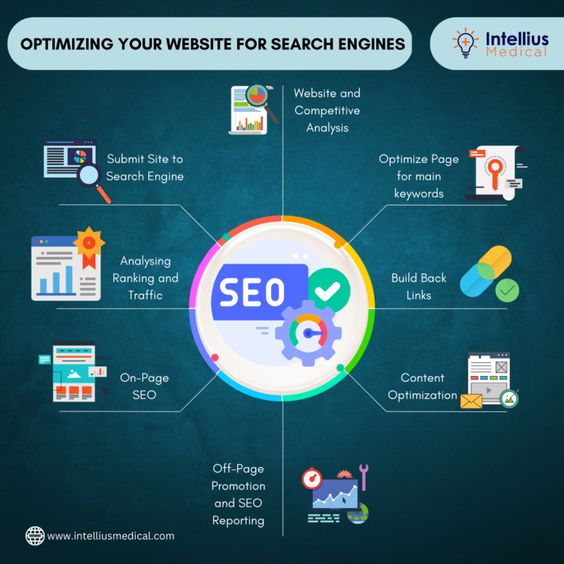
Image source: Pinterest
These techniques include:
Keyword research and optimization: Identifying the keywords patients use to search for healthcare services and incorporating them into your website content and metadata.
On-page optimization: On-page optimization refers to the process of optimizing individual web pages to rank higher and earn more relevant traffic in search engines. This includes optimizing your website’s content, metadata, and structure to make it more search engine-friendly.
Off-page optimization: Building links from other websites to your website, creating social media profiles, and engaging in other activities that improve your website’s online reputation.
SEO is critical in healthcare for several reasons. When done correctly, SEO helps to increase your website’s visibility and ranking on search engines, making it easier for patients to find your healthcare company. It establishes your healthcare brand as an authoritative source of information and expertise. And ultimately, it leads to higher patient engagement and satisfaction, as patients are more likely to trust healthcare brands appearing on the search engine’s first page of search results.
Keyword research is the heart of SEO efforts. It involves identifying the keywords patients use to search for healthcare services. You can use keyword research tools like Google Keyword Planner, SEMrush, and Ahrefs to identify keywords that resonate with your target audience.
After identifying relevant keywords, it is vital to strategically incorporate them to optimize your website content and metadata. This can be achieved by using relevant keywords in your website’s title tags, meta descriptions, and header tags. Additionally, creating high-quality content that provides value to patients while incorporating relevant keywords can significantly enhance the search engine visibility of your website.
Internal linking can also be utilized to create a hierarchy of pages on your website that effectively guides patients to the information they need.
On-page optimization techniques involve optimizing your website’s content, metadata, and structure to improve its search engine-friendliness. These techniques include creating high-quality content that adds value to your patients, optimizing your website’s metadata (including title tags, meta descriptions, and header tags), and utilizing internal linking to create a clear hierarchy of pages on your website.
Off-page optimization involves improving your website’s online reputation through various activities, such as building links from other high-quality, authoritative websites to your website. In addition, creating social media profiles on platforms such as Facebook, Twitter, LinkedIn, and others can be used to promote your healthcare brand and interact with patients.
Creating high-quality, shareable content can also encourage other websites to link back to your website, improving your website’s visibility and ranking on search engines.
By understanding the fundamentals of SEO and effectively incorporating on-page and off-page optimization techniques into your healthcare digital marketing strategy, you can attract more patients to your healthcare services, improve your website’s visibility and ranking on search engines, and establish your healthcare brand as an authoritative source of information and expertise.
Running PPC adverts is also another strategy to implement in digital marketing for your healthcare company. Let’s see.
PPC Adverts
Pay-per-click (PPC) advertising is a form of digital advertising that allows healthcare marketers to display ads on search engines and social media platforms. With PPC advertising, you only pay when a user clicks on your ad, making it a cost-effective way to reach and engage with patients.
For your healthcare company, you can create targeted PPC ads that appear on search engines and social media platforms when patients search for healthcare services related to your brand.
For example, you can create ads that target patients who search for “family doctors near me” or “cardiologists in New York City.”
Like content marketing, a solid strategy is crucial to launch a successful PPC campaign. Before diving into PPC ads, it’s vital to establish the campaign’s desired outcome. Whether it’s boosting website traffic, lead generation, or sales growth, clarity on the objective is necessary.
This is where your previously created buyer persona can be helpful. Identify your target audience’s demographics, interests, and behavior to determine whom you want to target with your ads.
Next, choose the PPC platform that aligns with your campaign goals. Whether it’s Google Ads, Bing Ads, Facebook Ads, or LinkedIn Ads, make sure to select the platform that best suits your needs.
After selecting the platform, create compelling ads that catch the attention of your target audience. The ads should include relevant keywords that potential patients use when searching for healthcare services.
Finally, set your PPC budget by determining how much you want to allocate to the campaign daily and monthly. This will help keep your ad spend under control and ensure you maximize your PPC campaigns’ potential.
Setting up your ad campaigns and running the ads isn’t a sure guarantee that you’ll see a surge in revenue or achieve your goals.
To increase the return on investment of your PPC campaigns, there are several optimization tips that you should follow.
One of the most crucial steps is to refine your ad targeting by adjusting your keywords, demographics, and interests to improve ad relevance and reach. This will help you reach your target audience more effectively and generate more quality leads.
Another essential aspect of optimizing PPC campaigns is to improve your ad quality score. Ad Quality Score is a metric used by search engines like Google to measure the relevance and usefulness of your PPC ads to users. It is based on several factors, including the relevance and quality of your ad’s keywords, ad copy, landing page experience, and historical click-through rate (CTR). The higher the score, the better your chance of converting customers with your ad.
You can increase your ad score by creating high-quality ads that provide value to patients and using relevant keywords in your ad copy and landing pages. By doing so, you can increase the visibility of your ads and improve their performance.
To track the success of your PPC campaigns, it’s essential to use conversion tracking. This helps you measure the conversion rate of your ads and optimize them for better results. You can track the number of clicks, form submissions, phone calls, and other key performance indicators to determine the effectiveness of your campaigns.
The data you get from tracking your ad would give you valuable insights into how to optimize future ads for better conversions.
Another trick to maximize your PPC efforts is to test different ad variations to determine which resonates best with your target audience and generates the best ROI. You can improve their performance and achieve better results by constantly testing and optimizing your PPC campaigns.
We can never say we’re discussing digital marketing without mentioning social media.
Social Media Marketing
Almost everyone is on social media these days. That’s why social media marketing is a powerful tool for healthcare providers to connect and engage with patients.
Social platforms such as Facebook, Twitter, Instagram, and LinkedIn allow healthcare marketers to share relevant information, provide support, and build relationships with patients.
If you’re looking to create captivating social media content, there are several techniques you can employ. Again, you must understand your audience. This insight will help you know exactly what they need and allow you to create content that resonates with them and keeps them engaged.
Another important technique is to leverage visual content.
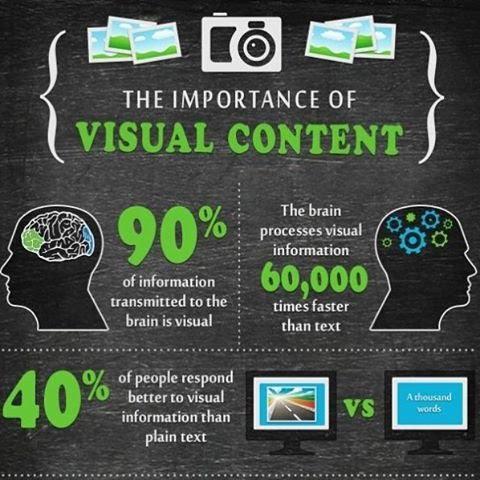
Image source: relevance.com
Statistics show that 91% of consumers prefer visual content over text-based content. Integrating visually striking elements such as images, videos, and infographics into your social posts can capture your audience’s attention and effectively communicate your message.
Remember, social media is a highly visual medium; strong visuals can make all the difference.
Providing valuable information is another effective strategy for your digital marketing in healthcare to succeed. You can share helpful and relevant healthcare service and industry insights that educate and inform your audience.
The key is to be authentic. Let your audience and customers see the human aspect of your company. Share genuine stories and experiences that showcase your brand’s personality and values.
Distributing this kind of information can help you connect with your audience more personally and create a sense of authenticity and trust.
Finally, it’s essential to adhere to social media best practices. Optimize your content’s reach and engagement by following best practices such as employing hashtags, promptly responding to comments and messages, and posting at opportune times.
These techniques can help you maximize your impact on social media and build a robust online presence.
Measuring the Success of Your Social Media Marketing Efforts
Measuring the success of social media marketing efforts for a healthcare company can be done using several metrics. Here are some key performance indicators (KPIs) that you can use to evaluate the success of your social media marketing efforts:
Reach
Reach refers to the number of people who have seen your social media posts. You can measure this by looking at the number of followers you have, the number of shares, retweets, or reposts, and the number of impressions (the number of times your content has been displayed).
Engagement
Engagement refers to people’s interaction level with your social media content. This includes likes, comments, shares, and direct messages. Measuring engagement can help you understand how your audience responds to your content.
Traffic
Measuring website traffic from social media can give you an idea of how many people are clicking through to your website from your social media channels. This can help you determine the effectiveness of your social media content in driving traffic to your website.
Conversions
Conversions refer to people’s actions after clicking through to your website from social media. This could include filling out a form, signing up for a newsletter, or buying something. Measuring conversions can help you understand how your social media content drives business outcomes effectively.
Brand Awareness
Social media is an excellent tool for building brand awareness. You can measure this by tracking the number of mentions of your brand, the number of new followers, and the sentiment of the conversations around your brand.
By regularly tracking these KPIs, you can evaluate the success of your social media marketing efforts for your healthcare company and make data-driven decisions to improve your social media strategy.
There are several tools available to measure the success of your social media marketing efforts. Typically, the social channel you use comes with an inbuilt analytics tool. When you’re using social media scheduling tools like Buffer or Hootsuite, they also have analytics to track the relevant KPIs of your social media posts.
Google Analytics is also invaluable for tracking your social media referral traffic and conversion rates.
If you produce compelling social media content and utilize appropriate tools and metrics to gauge your social media marketing effectiveness, you can enhance your social media reach and engagement, establish brand recognition, and generate additional leads and sales for your healthcare services.
Email Marketing
Email marketing can be a powerful tool for healthcare organizations to reach patients. Sending personalized and relevant emails can help healthcare providers provide valuable information, promote their services, and engage patients in their care.
Email marketing can help build patient relationships by providing relevant information and resources when structured correctly. It can also promote healthcare services, improve patient outcomes, save time and resources, increase patient retention, and ensure compliance with patient privacy laws.
By utilizing email marketing, healthcare providers can engage patients, increase loyalty, and ultimately improve the overall quality of care. Like any other aspect of marketing, some dos and don’ts govern email marketing, especially when it’s geared toward healthcare clients.
Email Marketing Best Practices
However, healthcare email marketing requires much more careful consideration of patient privacy laws and regulations and best practices for email marketing. Here are a few tips to remain compliant with the regulations and, at the same time, delight your healthcare clients.
Obtain Patient Consent
Before sending any marketing emails to patients, you must obtain their consent. You can do this through a sign-up form on the organization’s website or through an opt-in process at the point of care. The email consent should be separate from any other forms and clearly state the email’s purpose and what types of information will be included. Under no circumstance should you ‘buy’ an email list. You risk getting into legal trouble.
Segment your email list
Remember that not all patients have the same healthcare needs, so segmenting your email list to send targeted emails is essential. Segmenting by demographics, health conditions, or previous organizational interactions can ensure patients receive relevant and timely information.
Provide Valuable Content
The content of your emails is as important as any content you share online. It should provide value to patients, whether health tips, educational information or updates on your organization’s services. The content should be written in plain language and include links to additional resources.
Keep it Short and Sweet
People, in general, are often busy and don’t have time to read lengthy emails. Keep your emails concise and to the point, and include a clear call to action that tells patients what you want them to do next.
Personalize Your Emails
Personalization can go a long way in engaging patients with your emails. Use their first names in the greeting, and include information that is relevant to their specific health needs or interests.
Ensure Compliance with HIPAA
Healthcare organizations must ensure that all emails comply with the Health Insurance Portability and Accountability Act (HIPAA). This means that emails should not contain any protected health information (PHI) and that all emails should be encrypted and secure.
Test and Optimize
Email marketing is not a one-size-fits-all approach, so testing and optimizing your emails to see what works best for your patients is important. You can test different subject lines, CTAs, and email designs to see what generates the highest open and click-through rates.
Email marketing can be an effective tool for your healthcare company to engage patients and build relationships with them. By following these tips and best practices, you can ensure that your email marketing campaigns are compliant, personalized, and effective in reaching clients, customers, or patients.
Compliance and Ethics in Digital Marketing in Healthcare
Healthcare digital marketing is a complex area that requires careful attention to regulations and guidelines. Some of the most important regulations and guidelines include HIPAA, FDA, and FTC.
HIPAA ensures the confidentiality and security of patient health information, the FDA regulates the advertising and promotion of drugs and medical devices, and the FTC regulates advertising and marketing practices to ensure they are not deceptive or misleading.
To ensure compliance and ethical practices in healthcare digital marketing, healthcare providers and organizations can take several steps. These include conducting regular compliance training for employees, developing clear policies and procedures for digital marketing, and seeking legal counsel to review their digital marketing materials.
These may seem trivial, but failing to comply and unethical practices in digital marketing, regardless of how unintentional, can have serious consequences, such as fines and legal action, damage to reputation, and loss of trust.
Therefore, we urge you to prioritize compliance and ethics in your digital marketing efforts. We’ll advise you to get an attorney to help you stay compliant. If it’s above your budget, then kindly take the time to read as much as you can online about how these regulations work and how you can remain compliant.
If you do, we can assure you that you can build trust with patients and customers, improve patient outcomes, and ultimately drive business success.
Concluding Thoughts on Maximizing ROI in Healthcare with Digital Marketing
As healthcare becomes more digital, healthcare providers and organizations must adapt their marketing strategies to remain competitive and relevant. In this blog post, we’ve discussed maximizing ROI and engagement in healthcare digital marketing, future trends in healthcare digital marketing, and all the major channels you can use for digital marketing in healthcare.
To succeed in healthcare digital marketing, healthcare providers and organizations must prioritize their target audience, utilize multiple digital marketing channels, measure the success of their efforts with data analytics and reporting, and ensure compliance and ethical practices. As the healthcare industry evolves, healthcare providers and organizations must stay up-to-date with the latest trends and adapt their digital marketing strategies accordingly.
If you’re a healthcare provider or organization looking to improve your digital marketing efforts, here are some next steps you can take:
- Conduct a thorough review of your current digital marketing strategy to identify areas for improvement.
- Develop a comprehensive plan that includes personalized marketing strategies, multiple digital marketing channels, and data analytics and reporting.
- Seek legal counsel to ensure compliance and ethical practices in your digital marketing efforts.
- Stay up-to-date with the latest trends in healthcare digital marketing and adapt your strategy accordingly.
Following these steps can maximize ROI and engagement in your healthcare digital marketing efforts and ultimately drive business success.






0 Comments